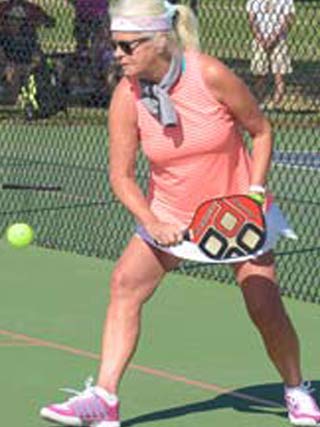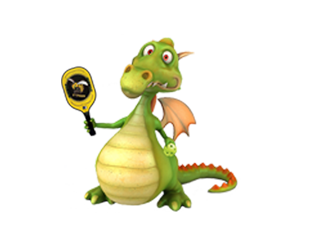How To Play
BASIC RULES
The complete official International Federation of Pickleball Rules can be found at: IF Pickleball - click to view more



WHAT NEW PLAYERS SHOULD KNOW
Improving Your Game:
Above all, learn the basic rules and do your very best to follow them. Watch for foot faults (yours and your friends). Make sure your serves are legal. Know when a ball is really in or out. Many new players don’t work at these rules and if you don’t, you are missing a very important part of the game. Further, when you play with more advanced players you are very likely to be called for violations.
Other Great Tips for New Players:
- Listen and accept suggestions that you’ve violated a rule. It’s to your benefit.
- Always get to the non-volley line when you can. It’s the strongest position.
- Face the player who will hit the ball, not the non-volley line. You will be in a better position to hit the ball.
- Keep you paddle high, near your chest. It’s easier to react to hard shots at you.
- Keep the ball in play. 75% of all rallies are won or lost because of unforced errors, many of them at the baseline. Don’t try to hit the ball right at the sidelines; the odds are too much against you. Let your opponent make the mistakes.
- Return serves soft and deep, that gives you time to get to the non-volley line.
- Don’t try to make hard serves or serves near the side lines.
- Return your baseline shots with your forehand and to the center line as often as you can.
- Use your forehand as much as you can, few people have as good a backhand as their forehand.
- Don’t short hop the ball at the baseline. Stand back a little to get a higher bounce.
- Keep both feet behind the baseline when serving or receiving a serve; remember that both the serve and the serve return must bounce before you can hit the ball.
- Don’t try to power the ball, location is much more important.
- Don’t try to make a lot of “sideline” shots they are a low percentage shot. Just try to hit to open areas.
- Always make note if an opponent is right or left handed. Avoid hitting to their strong side.
- Try to stay in the middle of your side of the court. Don’t take your partner’s shots away.
Evaluating Your Game:
- Learn to “Dink” the ball proficiently, be patient. Don’t try to make a “kill” shot unless it’s really there to make.
- Know when to hit the ball hard or softly. It’s not about power.
- Watch your opponent’s paddle hit the ball, it tells you a lot about where the return will be going and how hard it will be hit.
- Hit the ball to the opponent’s feet or backhand, especially if it’s weak.
- Develop a drop shot (just over the net) from the baseline. This is an important shot when your opponent(s) are at the non-volley line. Never use it when your opponents are back near the baseline. Work on a cross-court dink.
- “Ratchet” overhead smashes (straight arm). It works better than snapping your wrist.
- Have friends make some shots to you that you don’t like and work at returning them. Maybe your opponent doesn’t like them either. Try them on him or her.
- Look for patterns in your opponent’s play. Sometimes you can see things during pre-game warm-ups.
- When you see that your opponent is about to hit the ball try to stop moving, especially forward or backward. It’s much easier to hit the ball and control it if you are stationary.
SCORING & POSITION FOR BEGINNERS
By Bill Booth
Doubles Scoring
Points are scored only on the serve. The receiving side cannot score a point. At the start of the game, the player on the right side serves. If a point is scored, the server moves to the left side and serves to the opposite court. Each time that a point is scored, the players on the serving side alternate from the right to left or left to right. That player continues to serve until the serve is lost by losing a rally. Players on the serving team do not alternate sides unless a point is scored. The receiving side never alternates sides.
When the receiving team wins a service turn, the player on the right serves first and continues to serve and alternates sides each time that a point is won. When the first server loses the serve, the serve goes to the second server on the side. When the second server loses the serve, the serve goes to the other team and the player on the right serves first. That pattern continues throughout the game.
Call the score in the order of server’s score, receiver’s score, and then the server number. For example if the score of the serving team is 3 and the score of the receiving team is 6, and the second server on the side is serving, the score would be announced as 3-6-2. Some players might say “first” or “second” for the server number, for example 3-6-second. Either way is correct. Note that the server number is for that service turn only. Whoever is on the right when the team gets the serve back is the first server for that service turn only. The next time that the team gets the serve back, it might be the other player that is on the right and is the first server for that service turn only. Beginning players often mistakenly assume that the player keeps the same server number throughout the game.
It is important to call the score including the server number prior to each serve. That helps the players to keep the server and the score straight. When you announce, as part of the score, that you are the first server, everyone on the court knows that when you lose the serve, the serve goes to your partner. When you announce that you are the second server, everyone knows that when you lose the serve, the serve goes to the other team. To minimize the advantage of being the first team to serve in the game, only one player gets a service turn on the first service turn of the game. To help everyone remember that the serve goes to the other side when that player loses the serve, it is customary to say that the player is the last server or second server. Therefore, at the start of the game, it is customary to say that the score is 0-0-2. The “2″ means that the serve goes to the other side when the serve is lost.
At the start of each game, make a mental note of the player that served first for each side. If the rotation is done correctly, a team’s score will always be even when that player is on the right and odd when that player is on the left. As you call the score, use the player position as a double check on whether you have the correct score.
Singles Scoring
Singles scoring is very similar except that there is no second server. The serve is always done from the right side when the server’s score is even and from the left side when the server’s score is odd. Note that it is the server’s score that matters, not the combined score of server and receiver.

New Here? Get All The Answers You're Looking For




